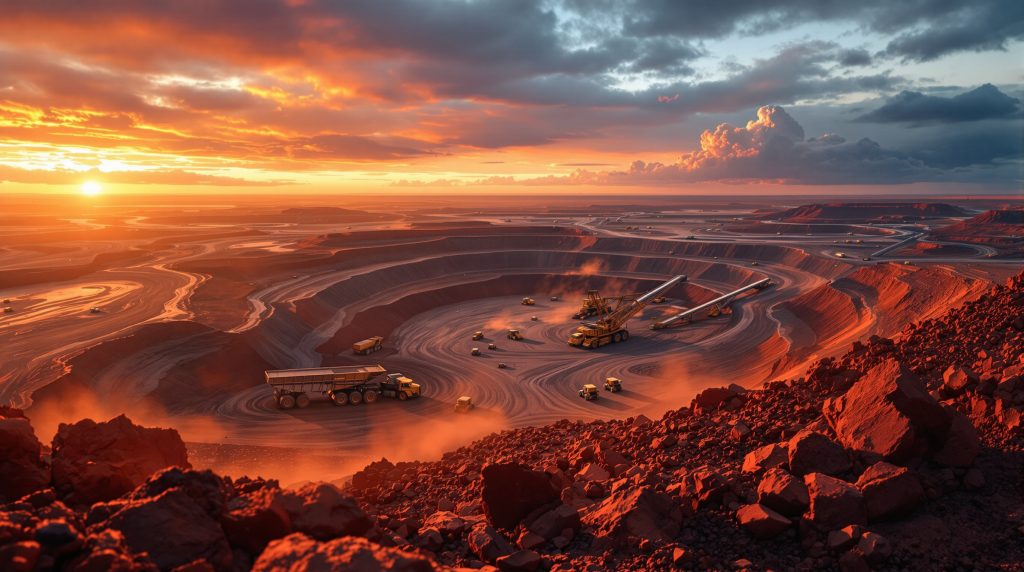BHP's Financial Performance: Understanding the Five-Year Profit Low and Iron Ore Market Challenges
BHP, one of the world's largest mining companies, has reported its smallest profit in five years, highlighting significant challenges in the global iron ore market. The mining giant posted an underlying attributable profit of $10.16 billion for the fiscal year ended June 30, 2025, representing a 25.6% decrease from the previous year's $13.66 billion earnings. This performance marks BHP's weakest financial result since 2020 and fell short of analyst expectations of $10.22 billion.
The substantial decline in profitability underscores the complex challenges facing major mining companies in today's volatile commodity markets. As global economic uncertainties persist and structural shifts reshape demand patterns, stakeholders across the mining sector are closely monitoring iron ore price trends and BHP's strategic response and future outlook.
What Caused BHP's Five-Year Profit Decline?
Market Pressures on Iron Ore
The iron ore market has experienced significant turbulence over the 2024-2025 financial year, creating persistent downward pressure on prices. This challenging environment stems from several interconnected factors that have fundamentally altered market dynamics:
Global oversupply conditions have intensified as major producing regions—including Australia, Brazil, and South Africa—have ramped up production volumes. New mining projects and expansion initiatives have brought substantial additional supply to market, outpacing demand growth and creating inventory buildup at major ports.
China's steel sector transformation has compounded these challenges. As the world's largest steel producer and iron ore consumer, China's reduced steel production rates have significantly impacted global demand patterns. Several factors have contributed to this shift:
- Implementation of stricter environmental regulations limiting production
- Slowdown in property construction activities
- Shift toward electric arc furnace technology using scrap steel
- Government-mandated production cuts to reduce emissions and address overcapacity
These supply-demand imbalances have created a perfect storm for iron ore prices, directly impacting BHP's most profitable commodity segment and driving the substantial earnings decline observed in the latest financial results.
Financial Performance Metrics
The $10.16 billion underlying attributable profit represents more than just a 25.6% year-over-year decline. This figure reflects a broader trend of financial compression after the extraordinary post-pandemic commodity price surge that benefited major miners between 2021-2023.
Key financial metrics tell a compelling story:
- EBITDA margin compression from 65% to 58%, indicating reduced operational efficiency
- Free cash flow reduction of approximately 30% year-over-year
- Return on capital employed (ROCE) falling below 20% for the first time since 2020
- Net debt position increasing by approximately $1.2 billion
These performance indicators collectively point to significant financial headwinds that extend beyond temporary market fluctuations, suggesting a more fundamental recalibration of industry economics that may persist through the medium term.
How Did BHP's Dividend Policy Respond to Lower Profits?
Dividend Reduction Analysis
In response to the challenging market conditions and reduced profitability, BHP has announced a final dividend of $0.60 per share, down from $0.74 per share in the previous year. This adjustment brings the total annual dividend payout to $1.10 per share, representing the weakest dividend distribution since 2017.
The dividend reduction reflects BHP's prudent financial management approach amid market uncertainty. By moderating shareholder returns, the company aims to preserve capital for operational needs and maintain financial flexibility in a volatile commodity price decline analysis environment.
Key aspects of the dividend decision include:
- Payout ratio maintained at approximately 65% of underlying earnings
- Focus on balancing shareholder returns with balance sheet strength
- Retention of financial flexibility for potential strategic opportunities
- Commitment to the company's progressive dividend policy despite market challenges
This conservative approach to capital allocation demonstrates management's recognition of the structural challenges facing the iron ore market and the need to maintain financial resilience through the cycle.
Shareholder Return Strategy
BHP's approach to shareholder returns during this challenging period reflects a delicate balancing act between meeting investor expectations and ensuring long-term financial sustainability. The reduced dividend has generated mixed reactions among the investment community:
- Income-focused investors express disappointment at lower yields
- Value investors appreciate the prudent capital management approach
- Long-term holders recognize the cyclical nature of commodity markets
Historical context is important when evaluating BHP's current dividend strategy. During the 2015-2016 commodity downturn, BHP abandoned its progressive dividend policy entirely, highlighting the relative resilience of the current approach despite market pressures.
The company's stock performance has reflected these dividend adjustments, with share prices experiencing moderate volatility following the financial results announcement. However, the maintenance of a substantial dividend despite challenging market conditions demonstrates management's confidence in BHP's long-term fundamentals and commitment to shareholder returns through market cycles.
What's Happening in the Global Iron Ore Market?
Supply-Demand Imbalance
The global iron ore market is experiencing a significant recalibration driven by supply expansions across key producing regions. Production increases have been particularly notable in:
Australia's Pilbara region: Major miners have completed several brownfield expansion projects, adding approximately 40-50 million tonnes of annual capacity. These expansions have featured enhanced automation, improved logistics infrastructure, and optimized extraction methodologies that have simultaneously reduced production costs.
Brazil's recovery and growth: Following years of production constraints after the Brumadinho dam disaster, Brazilian output has steadily recovered. Vale has systematically restored lost capacity while simultaneously developing new projects that have added approximately 30 million tonnes of annual production.
South Africa's renewed output: Several previously idled operations have resumed production amid improved infrastructure conditions and operational efficiencies, contributing an additional 15-20 million tonnes to global supply.
Transportation and logistics developments have further enhanced market access, with significant expansions in rail capacity, port handling capabilities, and shipping efficiencies. These improvements have reduced delivery times and transportation costs, effectively bringing more supply to market more efficiently.
China's Changing Demand Patterns
China's steel industry, which consumes approximately 70% of global seaborne iron ore, has undergone significant transformation during 2024-2025:
- Production restrictions have been implemented across multiple provinces to reduce carbon emissions and address overcapacity concerns
- Property sector challenges have reduced steel demand from construction activities, which typically account for 30-35% of Chinese steel consumption
- Infrastructure investment moderation after years of stimulus-driven growth
- Increased scrap utilization in steelmaking, reducing reliance on iron ore inputs
Environmental regulations have particularly impacted production methods, with stricter emissions standards forcing older, less efficient blast furnaces to close or operate at reduced capacities. This transition has favored electric arc furnace technology, which uses primarily scrap steel rather than iron ore.
Economic growth patterns in China have also evolved, with greater emphasis on consumption and services rather than heavy industry and construction. This structural shift represents a fundamental change in China's resource consumption model that may have lasting implications for iron ore forecast 2025 and beyond.
How Does This Compare to Other Major Mining Companies?
Industry-Wide Performance Metrics
BHP's financial performance decline mirrors similar challenges faced by other major mining companies, though with notable variations in impact severity and strategic responses:
Rio Tinto has reported comparable profit declines of approximately 20-25%, slightly outperforming BHP due to its even greater exposure to iron ore and operational efficiencies at its Pilbara operations.
Vale has experienced more pronounced challenges, with earnings reductions exceeding 30% amid production recovery efforts and higher operational costs in Brazil.
Fortescue Metals Group has seen margin compression but benefited from its focus on operational efficiency and cost reduction initiatives.
Profit margin trends across the sector show a consistent pattern of compression, with industry-wide EBITDA margins contracting by 5-10 percentage points compared to previous years. Cost management has become a central focus, with major producers implementing various strategies:
- Automation and digitalization initiatives
- Energy efficiency improvements
- Workforce optimization
- Supply chain rationalization
- Maintenance schedule optimization
Operational efficiency metrics reveal interesting competitive dynamics, with some producers achieving significant cost reductions through technological innovation and scale efficiencies. The industry-wide C1 cash cost curve has flattened somewhat, compressing the cost advantage previously enjoyed by the largest iron ore mines.
Competitive Positioning
Market share dynamics among top iron ore producers have remained relatively stable despite the challenging environment, with the "Big Four" (Vale, Rio Tinto, BHP, and Fortescue) maintaining their collective dominance of seaborne supply. However, subtle shifts have occurred as producers adapt to changing market conditions:
- Enhanced focus on product quality and grade differentiation
- Increased emphasis on "green premium" products with lower environmental footprints
- Strategic repositioning toward future-facing commodities
Diversification strategies have become increasingly important as companies seek to mitigate commodity price risks. BHP's portfolio, which includes copper, nickel, and potash assets alongside its iron ore operations, provides some insulation from iron ore market volatility compared to more concentrated competitors.
Capital allocation priorities have shifted noticeably across the industry, with major miners demonstrating greater discipline in project approvals and emphasizing brownfield expansions over greenfield developments. This approach reflects a more cautious outlook on long-term demand growth and heightened focus on returns optimization.
What Are BHP's Strategic Priorities Moving Forward?
Portfolio Optimization
In response to the challenging market environment, BHP has intensified its focus on portfolio optimization to enhance resilience and position for future growth. The company's strategic approach centers on several key initiatives:
High-margin, long-life asset prioritization has become increasingly evident in capital allocation decisions. BHP continues to direct investment toward its Tier 1 operations with the lowest cost positions and longest reserve lives, ensuring sustainable returns through market cycles.
Divestment of non-core operations has accelerated, with the company exiting several thermal coal assets and reviewing its petroleum portfolio. These moves align with both financial optimization objectives and the company's climate change commitments.
Capital allocation discipline remains paramount, with rigorous hurdle rates applied to all investment decisions. The company has maintained its commitment to:
- 20%+ IRR requirements for major capital projects
- Payback periods of less than 5 years for most new developments
- Preference for brownfield expansions over greenfield investments
- Balanced approach between growth capital and shareholder returns
Diversification beyond iron ore continues through targeted investments in "future-facing" commodities. The company's Jansen potash project in Canada represents a significant step toward agricultural exposure, while copper and nickel investments position BHP to benefit from electrification and energy transition trends.
This disciplined approach to portfolio management demonstrates BHP's long-term strategic vision and commitment to creating sustainable shareholder value despite near-term market challenges.
Operational Excellence Initiatives
BHP has implemented a comprehensive suite of operational excellence initiatives designed to enhance productivity, reduce costs, and improve sustainability performance:
Technology implementation has accelerated across BHP's operations, with particular emphasis on:
- Autonomous haulage systems at iron ore and coal operations
- Predictive maintenance technologies to reduce equipment downtime
- Advanced analytics for process optimization and yield improvement
- Remote operations capabilities enhancing safety and efficiency
Supply chain optimization efforts have focused on reducing logistics costs and improving inventory management. Key initiatives include:
- Rail network capacity enhancements
- Port loading efficiency improvements
- Strategic supplier partnerships
- Inventory reduction programs
Cost reduction strategies have yielded meaningful results, with the company reporting approximately $1.5 billion in sustainable cost savings during the fiscal year. These efforts have partially offset the impact of lower commodity prices and helped maintain competitive margins despite market pressures.
Energy transition initiatives have dual benefits of reducing operational costs while advancing sustainability objectives. BHP has accelerated renewable energy integration across its operations, with several sites transitioning to wind and solar power through strategic power purchase agreements.
These operational excellence initiatives demonstrate BHP's commitment to controlling the controllable aspects of its business despite external market challenges.
How Might Iron Ore Markets Evolve Through 2025-2026?
Supply Outlook
The iron ore supply landscape is expected to undergo further evolution through 2025-2026, with several key trends shaping market dynamics:
New production capacity continues to advance through the development pipeline, with approximately 80-100 million tonnes of additional annual supply expected to enter the market over the next 18-24 months. Major projects include:
- Expansions at existing operations in Australia's Pilbara region
- New developments in Brazil's Iron Quadrangle
- Emerging projects in West Africa, particularly Guinea's Simandou region
Potential mine closures may partially offset these additions, as higher-cost producers struggle to maintain profitability in a lower price environment. Operations in the third and fourth quartiles of the cost curve face particular pressure, with potential rationalization of 30-40 million tonnes of annual capacity.
Regulatory changes in key producing regions could influence production capabilities, with growing emphasis on:
- Environmental compliance requirements
- Water usage restrictions
- Community benefit sharing arrangements
- Carbon pricing mechanisms
These supply factors suggest continued market balance challenges through 2025-2026, with gradual adjustment expected as higher-cost production exits the market and demand patterns stabilize.
Demand Forecasts
Iron ore demand projections for 2025-2026 reflect complex and sometimes contradictory factors influencing consumption patterns:
Steel industry growth forecasts have moderated, with global production expected to increase by just 1-2% annually over the medium term. Regional variations are significant:
- Chinese production likely to remain flat or slightly decline
- Indian output projected to grow 5-7% annually
- Southeast Asian production increasing 3-4% annually
- European and North American output stabilizing after recent declines
Alternative materials impact continues to grow, with increasing utilization of:
- Scrap steel in electric arc furnaces
- Alternative reduction technologies using hydrogen
- High-strength materials reducing steel intensity in some applications
Regional consumption shifts are becoming more pronounced, with China's share of global steel production gradually declining while India and Southeast Asia increase their proportion of world output. This geographical redistribution has important implications for trade flows and pricing dynamics.
Infrastructure development plans in key markets provide some support for steel demand, particularly in emerging economies pursuing urbanization and connectivity initiatives. However, the pace and scale of these developments remain subject to economic conditions and public financing capabilities.
The demand outlook suggests a gradual transition toward a more balanced market over the medium term, though significant uncertainties remain regarding the pace and extent of China's steel production trajectory.
What Are the Investment Implications for Mining Sector Stakeholders?
Risk Assessment
Investors in the mining sector face a complex risk landscape requiring careful assessment and strategic positioning:
Commodity price volatility is likely to persist, with iron ore particularly susceptible to supply-demand imbalances and sentiment-driven trading patterns. Price ranges of $80-120 per tonne appear plausible, with potential for temporary excursions beyond these boundaries driven by specific market events.
Geographic and political risks continue to evolve, with increasing focus on:
- Resource nationalism in producing countries
- Community relations and social license challenges
- Climate policy impacts on mining operations
- Trade tensions affecting global commodity flows
Operational challenges have intensified amid inflationary pressures affecting:
- Labor costs and availability
- Energy expenses
- Equipment and consumable prices
- Transportation and logistics expenses
These cost pressures have compressed margins across the sector and heightened the importance of operational efficiency and technological innovation.
Capital expenditure requirements remain substantial despite more disciplined approaches to project development. Major miners collectively face tens of billions in sustaining capital needs alongside growth investments, necessitating careful balance sheet management and capital allocation.
Opportunity Identification
Despite these challenges, the mining sector continues to present compelling opportunities for strategic investors:
Market rebalancing timelines suggest potential improvement in iron ore fundamentals by late 2026, as supply rationalization and stable demand create more favorable pricing conditions. Positioning ahead of this potential inflection point may offer attractive risk-reward profiles for patient investors.
Diversification strategies have gained prominence, with particular interest in:
- Battery metals (lithium, nickel, cobalt)
- Copper and other electrification-related commodities
- Agricultural minerals (potash, phosphates)
- Critical minerals with supply security concerns
Valuation considerations for mining equities have shifted, with many major producers trading at historically low multiples of:
- 4-6x EV/EBITDA
- 8-12x price-to-earnings
- 1.0-1.5x price-to-book
These compressed valuations may offer attractive entry points for investors with longer-term horizons, particularly given the substantial free cash flow generation capabilities of major miners even in challenging price environments.
Long-term secular trends supporting mining fundamentals remain intact despite near-term challenges:
- Urbanization in emerging economies
- Infrastructure development needs globally
- Energy transition requiring substantial mineral inputs
- Agricultural productivity demands
These structural factors suggest continued demand for mining demand insights over the long term, providing fundamental support for well-positioned producers despite cyclical challenges.
FAQ: BHP's Financial Performance and Iron Ore Market
What factors contributed most to BHP's profit decline?
The primary drivers were lower iron ore prices due to oversupply from major producing regions including Australia, Brazil, and South Africa, combined with reduced demand from China's steel sector. This created persistent downward pressure on BHP's most profitable commodity segment throughout the financial year. Secondary factors included cost inflation in labor, energy, and consumables, which compressed margins despite productivity initiatives.
How does BHP's current profit compare to historical performance?
The $10.16 billion underlying profit represents BHP's weakest financial performance since 2020, marking a significant departure from the stronger results achieved during the post-pandemic commodity price surge. However, this performance remains substantially above the levels seen during previous downcycles, reflecting the company's improved cost position and operational efficiency. For context, BHP's profits during the 2015-2016 downturn fell below $5 billion.
What strategies is BHP implementing to address these challenges?
BHP is pursuing a multi-faceted approach centered on operational efficiency, portfolio optimization, and disciplined capital allocation. The company has accelerated technology adoption, including autonomous operations and predictive maintenance, to enhance productivity. Cost reduction initiatives have delivered approximately $1.5 billion in sustainable savings. Portfolio management remains active, with continued focus on high-quality, long-life assets and strategic positioning in future-facing commodities.
How might iron ore markets evolve in the coming year?
Market analysts anticipate continued supply-demand rebalancing efforts, with potential production discipline from major miners and stabilizing demand patterns from China. However, new supply additions from projects already in development and economic uncertainty could extend the current pricing pressures. The potential development of Guinea's Simandou deposits represents a significant variable in the medium-term supply outlook, while China's property sector performance and infrastructure investment will heavily influence demand dynamics.
Disclaimer: This article contains forward-looking statements and market projections that are subject to various risks and uncertainties. Actual outcomes may differ materially from those anticipated. The information presented is for educational purposes only and should not be considered investment advice. Readers should conduct their own research and consult with financial advisors before making investment decisions.
Want to Be the First to Discover the Next Big Mining Stock?
Discover high-potential ASX mineral discoveries before the market does with Discovery Alert's proprietary Discovery IQ model, turning complex announcements into actionable insights. Visit our discoveries page to understand how historic mineral discoveries have generated exceptional returns for early investors.




